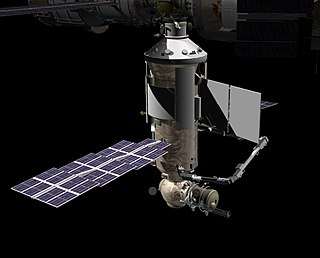
The International Space Station (ISS) is a space station in low Earth orbit. The ISS programme is a joint project between five participating space agencies: NASA, Roscosmos (Russia), JAXA (Japan), ESA (Europe), and CSA (Canada). The ownership and use of the space station is established by intergovernmental treaties and agreements.
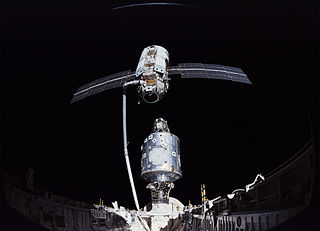
STS-88 was the first Space Shuttle mission to the International Space Station (ISS). It was flown by Space Shuttle Endeavour, and took the first American module, the Unity node, to the station.
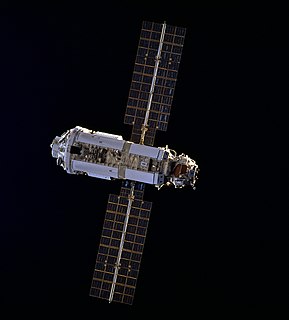
Zarya, also known as the Functional Cargo Block or FGB, is the first module of the International Space Station to be launched. The FGB provided electrical power, storage, propulsion, and guidance to the ISS during the initial stage of assembly. With the launch and assembly in orbit of other modules with more specialized functionality, Zarya is now primarily used for storage, both inside the pressurized section and in the externally mounted fuel tanks. The Zarya is a descendant of the TKS spacecraft designed for the Russian Salyut program. The name Zarya, which means sunrise, was given to the FGB because it signified the dawn of a new era of international cooperation in space. Although it was built by a Russian company, it is owned by the United States.
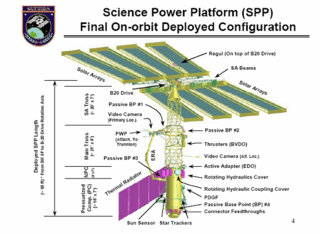
The Science Power Platform (SPP) was a planned Russian element of the International Space Station (ISS) that was intended to be delivered to the ISS by a Russian Proton rocket or Zenit rocket but was shifted to launch by Space Shuttle as part as a tradeoff agreement on other parts of the ISS.
The Russian Research Module (RM) was to be a Russian component of the International Space Station (ISS) that provided facilities for Russian science experiments and research.

The Unity connecting module, also known as Node 1, was the first U.S.-built component of the International Space Station. It is cylindrical in shape, with six berthing locations facilitating connections to other modules. Unity measures 4.57 metres (15.0 ft) in diameter, is 5.47 metres (17.9 ft) long, made of steel, and was built for NASA by Boeing in a manufacturing facility at the Marshall Space Flight Center in Huntsville, Alabama. Unity was the first of the three connecting modules; the other two are Harmony and Tranquility.

The TKS spacecraft was a Soviet spacecraft conceived in the late 1960s for resupply flights to the military Almaz space station.

Pirs – also called "Stykovochny Otsek 1" ("SO-1") (Russian: Стыковочный отсек, "docking module" and DC-1 – is a Russian module on the International Space Station. Pirs was launched in August 2001. It provides the ISS with one docking port for Soyuz and Progress spacecraft, and allows egress and ingress for spacewalks by cosmonauts using Russian Orlan space suits.

Mir-2 was a Soviet space station project which began in February 1976. Some of the modules built for Mir-2 have been incorporated into the International Space Station (ISS). The project underwent many changes, but was always based on the DOS-8 base block space station core module, built as a back-up to the DOS-7 base block used in the Mir station. The DOS-8 base block was eventually used as the Zvezda module of the ISS. Its design lineage extends back to the original Salyut stations.

Rassvet, also known as the Mini-Research Module 1 (MRM-1) and formerly known as the Docking Cargo Module (DCM), is a component of the International Space Station (ISS). The module's design is similar to the Mir Docking Module launched on STS-74 in 1995. Rassvet is primarily used for cargo storage and as a docking port for visiting spacecraft. It was flown to the ISS aboard Space ShuttleAtlantis on the STS-132 mission on May 14, 2010, and was connected to the ISS on May 18. The hatch connecting Rassvet with the ISS was first opened on May 20. On 28 June 2010, the Soyuz TMA-19 spacecraft performed the first docking with the module.

The process of assembling the International Space Station (ISS) has been under way since the 1990s. Zarya, the first ISS module, was launched by a Proton rocket on 20 November 1998. The STS-88 shuttle mission followed two weeks after Zarya was launched, bringing Unity, the first of three node modules, and connecting it to Zarya. This bare 2-module core of the ISS remained uncrewed for the next one and a half years, until in July 2000 the Russian module Zvezda was launched by a Proton rocket, allowing a maximum crew of two astronauts or cosmonauts to be on the ISS permanently.

Soyuz TMA-17 was a human spaceflight mission to the International Space Station (ISS). TMA-17 crew members participated in ISS Expedition 22 and Expedition 23. The mission ended when the Soyuz TMA-17 capsule landed on June 2, 2010.

The Functional Cargo Block or FGB was part of the Soviet TKS spacecraft. The TKS spacecraft was intended to be used as a resupply craft for Almaz space stations and saw some test flights in the Salyut space station program. The TKS spacecraft was formed by mating a FGB with a VA spacecraft, with both the VA and the FGB being capable of independent operation.
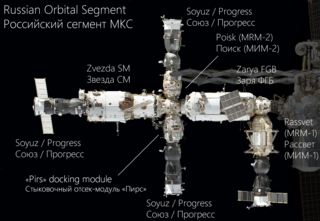
The Russian Orbital Segment (ROS) is the name given to the components of the International Space Station (ISS) constructed in Russia and operated by the Russian Federal Space Agency (Roscosmos). The ROS handles Guidance, Navigation & Control for the entire Station.

The Strela cranes are four Russian built cargo cranes used during EVAs to move cosmonauts and components around the exterior of the Soviet/Russian space station Mir and the Russian Orbital Segment of the International Space Station.
The Universal Docking Module (UDM), was a planned Russian docking module for the International Space Station, to be jointly built by RKK Energia and Khrunichev. The Uzlovoy Module addition to the Nauka module, the eventual form of the FGB-2 design upon which the UDM was based, grew out of this proposal.

Nodal module "Prichal" also known as Uzlovoy Module or UM is a Russian spacecraft which will form part of the International Space Station (ISS), and later, when the ISS program is closed, the proposed Russian OPSEK space station. Approved in 2011 and scheduled for launch in 2020, it is designed to connect modules of the ISS and OPSEK.
